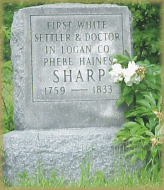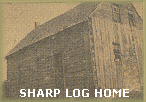| |
MARKS CHURCH SITE.
Historical Society Dedicates Darby Creek Roadside Marker.
With perfect weather and an interested audience Sunday afternoon the Logan County Archeological and Historical Society erected a large roadside marker at the site of the first church in the county. It was the Darby Creek Friends Meeting, about a mile out of Middleburg on the road to East Liberty.
President H. C. Marmon, of Bellefontaine, opened the roadside meeting, honoring the memory of the pioneers that brought God's worship with them. The Goshen-Pickerelltown male quartet, consisting of Lloyd Lockwood, Sam Lovett, Walter Stanly, and Alton Hughes sang, "My Anchor Holds". Secretary G. W. Furbay of Zanesfield then gave a brief history of the honored church.
"When the pioneer settlers first came into this part of the country", he said "they worshipped in their log cabin homes. Along the Indian trail leading from what is now Middleburg to East Liberty, a typical two-room Friends Church was built where the men could worship in one room while the women met in the other.
In 1806 John Sharp, Mose Ewings, Thomas Antrim and Carlisle Haines organized the meeting and in 1808 petitioned the Miami Friends Meeting to set them up as a Monthly Meeting.
"As other Friends came in they settled ever westward into the Marmon Valley where Goshen Meeting was established by Darby Friends. And Goshen became the main Quaker center, while Darby deceased. By October 1832 it had dwindled until Goshen asked that Darby Meeting be "laid down". The church building was moved across the road and incorporated in the Hatcher home, and later the Zane township trustees took over the care of the burial ground."
Elmer Heath, who lives on a portion of the farm where the church was built, added some personal history of these pioneers, and introduced the great, great, great, great granddaughters of the first minister of the Darby meeting [Editor's note: that first minister was none other than Thomas Antrim]. They are Janey and Gerry Heath, daughters of Mr. and Mrs. Homer Heath, of Columbus, who is a son of Mr. and Mrs. Elmer Heath, of Middleburg.
O. K. Reames of Zanesfield then erected and dedicated the marker to the sacred memory of the godly colonists who built this first church. The ceremony closed with a prayer offered by the Friends Minister at Goshen, Rev. H. H. Mosher.
|
|
|
|
|
Crowd Dedicates Memorial Marker To Woman Doctor
Memory of Dr. Phoebe Haines Sharp is honored by unveiling ceremonies held Sunday.
Mrs. Metta Landgraver, great-granddaughter of Dr. Sharp,
unveils stone and leads singing.
Examiner article by Dalton A. Young
 MIDDLEBURG, OH - AUGUST 1941 -- In the presence of relatives from this and many other communities from all sections of the State, the New England granite monument honoring the memory of a remarkable Logan county woman, Dr. Phoebe Haines Sharp, was unveiled at 4 p.m. Sunday in a field bordering the East Liberty -Middleburg pike. More than 50 automobiles lined the highway as their occupants gathered about the small fenced-off space, opened from the highway, which formed a picturesque setting for the monument. The ceremony was both colorful and impressive.
MIDDLEBURG, OH - AUGUST 1941 -- In the presence of relatives from this and many other communities from all sections of the State, the New England granite monument honoring the memory of a remarkable Logan county woman, Dr. Phoebe Haines Sharp, was unveiled at 4 p.m. Sunday in a field bordering the East Liberty -Middleburg pike. More than 50 automobiles lined the highway as their occupants gathered about the small fenced-off space, opened from the highway, which formed a picturesque setting for the monument. The ceremony was both colorful and impressive.
Heber Henke of the American Legion, representing also the Logan County Historical Society, as did Roy Blessing, Secretary of the Bellefontaine Chamber of Commerce, led the opening song "America."
Prentiss Sharp, a descendent of the honored woman, also President of the Sharp reunion organization, was in charge of the program.
Rev. W. H. Randall, pastor of the Goshen Friends church, reading from the Daniel Antrim Bible, read the Scripture lesson and offered a prayer. Mrs. Metta Landgraver, a great- granddaughter of Dr. Phoebe Sharp, unveiled the monument and singing of "Blest Be the Tie That Binds" and a prayer by Rev. Leland Wiley concluded the program.
Baskets of flowers had been placed about the monument and additional color was added by the presence of Bellefontaine Police Captain S. E. Hostetler, attired in the dress of the famed Indian, Chief Blue Jacket.
Dr. L. E. Traul, of Middleburg and Bellefontaine, representing the Logan County Medical Society; Attorney and Mrs. Dow Aiken, Job C. Sharp, Mrs. F.E. Hines, of Greenwich, and others were present. Dr. Traul's biography of Dr. Sharp, which he head as a part of the ceremonies, is as follows:
Dr. Phoebe Haines Sharp was born in a Friends settlement in the colony of Burlington County, N. J., where the Haineses were large land owners. She came from the Puritan stock of England. After marriage she went into Pennsylvania near Philadelphia. Then after the Revolutionary War the family and other Quaker relatives went into Culpeper County, Va. Her parents were Solomon and Rebecca Haines, persons of prominence in that colony.
She counted among her ancestors teachers, preachers, and high government officials. One of the latter played so important a part in framing governmental policies that his portrait hangs in Independence Hall in Philadelphia.
In childhood she became so impressed with the opportunity of service to her fellow man in the medical profession that she brooked the irony and contempt imposed upon a woman who was so forward as to enter upon one of the learned professions. Encouraged by educated parents, she prepared for the medical profession. Her prepatory education was obtained in New Jersey schools and her professional studies in Philadelphia.
She married Job Sharp, a fine surveyor, and the son of a noted surveyor. They went into Culpeper County, Va., in a Quaker colony, about 1796. Here they were brought face to face with the enormities of the African slave traffic as it was shown there, and they determined to seek a home where this plague would not face them and their children. The ordinance of 1787 was open for settlement, miles upon miles of woodland and forests. One clause in that State paper was appealing: "Slavery should always be prohibited."
A Virginia neighbor, Philip Slaughter, had obtained patents for several 1,000-acres of surveys of military land in this Northwest Territory. After taking a trip into this territory Job returned to Virginia and deeded his lands in October 20, 1800, to Slaughter in return for 500 acres in survey No 3154 near what is now Middleburg. The family moved to this farm in 1801. The group consisted of a son, Joshua, a daughter Ocsah [Ascah] McWade and husband, Arthur, a young daughter, Sarah, and Phoebe's brother, Carlisle Haines, and wife. They arrived in 1801 [Christmas Day].
 Job Sharp surveyed thousands of acres of land in what are now Champaign and Logan counties, while Phoebe rode across hills and vales administering to bodies and souls of all within her reach, rich or poor, white or Indian. The relatives with large families followed the Sharp family quite fast, obtained large acreage and they had their Quaker colony. They were never molested by Indians and nobody ever went away hungry from the Sharp cabin. It was Phoebe Sharp's dying request that she be buried on this knoll at the side of the Indian path. Her great living desire was "Let me live by the side of the road and be a friend to man." It was so done. She passed to her reward and her body was placed near the designated burial spot.
Job Sharp surveyed thousands of acres of land in what are now Champaign and Logan counties, while Phoebe rode across hills and vales administering to bodies and souls of all within her reach, rich or poor, white or Indian. The relatives with large families followed the Sharp family quite fast, obtained large acreage and they had their Quaker colony. They were never molested by Indians and nobody ever went away hungry from the Sharp cabin. It was Phoebe Sharp's dying request that she be buried on this knoll at the side of the Indian path. Her great living desire was "Let me live by the side of the road and be a friend to man." It was so done. She passed to her reward and her body was placed near the designated burial spot.
Update - July 2001
After the dedication ceremonies held over 60 years ago, I'm pleased to say that the markers described in these articles still stand on the original sites on the former "East Liberty-Middleburg Road" (now Zane Township Rd 152).
Sadly, the historic log home was razed during the early part of WWII. Up until then, it had been used as a residence by Robert & Nancy Cochran, a playhouse by the local children and as an outside kitchen for canning during the summer months.
The home that currently stands on the Sharp Farm was built in approximately 1900.
|
|

